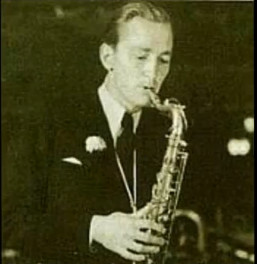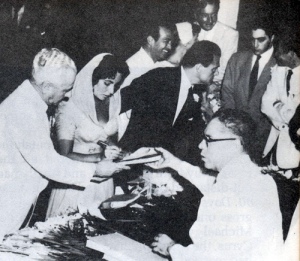Friday nite videos: Mr. Teddy, Joseph Goebbels and La India Maria
Under the leadership of Swiss saxophonist Ernst Heinrich Stauffer, better know as Teddy, the Original-Teddies were the top swing and jazz orchestra in Germany in the late 1920s and throughout the 1930s.
Having one’s music labeled “degenerate” by some anal-retentive politician today might boost record sales (and the Original-Teddies sold very well throughout their career), but when the bureaucrat in question was Josef Goebbels, there was, indeed, a problem. Interviewed by Bob Alvardo for “El AntiQuario” in his old age, Stauffer said the problem wasn’t just that Jazz was Afro-American music, but something even worse according to the Nazis:
Swing music was my problem in Europe. When the Nazis put on the blacklist all the Jewish composers, the songs, I was already on the list one year and a half. With the revolution in Europe, Swing music was forbidden, Swing dancing forbidden. Nobody know what Swing is, they forbid something that is only bad imitation. They didn’t have it, we had it. That made us number one. I came to America in 1941. I came on the refugee ship. I am not Jewish, but I was on the blacklist for the music that we made.
Perhaps Stauffer was prescient when the Original-Teddies recorded Chica-Chica-Boom-Chic in 1941. It would be a more tropical locale than Hollywood — where he hoped to get work as a studio musician — where Stauffer found refuge in 1942. Lou Christine (who also writes for Atención San Miguel) picks up the next chapter in Stauffer’s checkered career in a fine article written for The (Mexico City) News last week:
The U.S. seemed like a safe haven and a place to continue his musical career but because his passport was stamped with a swastika, he was barred from residing north of the border. Stauffer was soon on a bus to Mexico City. To his delight on his first day in this nation’s capital, while passing a record store, he spotted his band’s album featured in the store’s window. As fast as you can say, “que padre,” Mexico absorbed the vivacious Stauffer the way a tortilla sucks up anything tasty. In no time he was operating his own jazz club, “The Casanova” in Mexico City. Yet upon his first visit to Acapulco, Stauffer realized his calling and vast potential.
With deep-pocketed backers he opened “The Casa Blanca Hotel” at the seaside, soon-to-be resort, town. Before long, Acpulco’s first nightclub “La Perla,” was opened. The post-WWII crowd was ready to party. With Stateside contacts and Mexican amigos, he imported other music stars, along with the famous, whose appetite for good times matched their stardom. Stauffer’s good looks and irresistible charm mesmerized most comers. The Guerrero Governor appointed Stauffer as the town’s good-will ambassador while naming him Mr. Acapulco as the seaside portion of the town went from rags to riches.
Stauffer became famous for being the first hotel operator to install a swimming pool at a seaside hotel. Many scoffed, said he was crazy, and asked, who wanted a pool when there was an ocean a stone’s throw away? Mr. Teddy wouldn’t permit detractors to sway him. He was hell-bent on making éapulco a place that would be a spectacular gem second to none. His poolside parties outdid any beach party bingo.
“The Casanova”, might not have lasted as a club, but as a name, it presaged Teddy’s career in Acapulco. Stauffer put a different meaning on “swing”, and — with his good buddy Errol Flynn — gave Acapulco it’s head start on the “swinging sixties”. Always one to mix business with pleasure, the compulsive womanizer had a soft spot for weddings. Elizabeth Taylor and Mike Todd’s 1957 wedding was not the only one Mr. Teddy arranged. He liked Acapulco weddings so much, he married five times between arriving in Acapulco and his death at the age of 81 in 1991.
Although also remembered for opening the port’s first shopping mall, organizing tennis tournaments and turning the la Quebrada cliff divers into a lucrative tourist attraction, Mr. Teddy is remembered most for his clubs. His greatest creation (or, perhaps, most “degenerate” act) was Tequila A Go-Go — the first discotheque in Latin America.
 María Elena Velasco directed as well as starred in a series of satirical farces centered around Maria, a traditional indigenous woman who prevails over the villains and villainy of modern Mexico, her native wit and grit put to the test by gangsters, crooked cops, greedy criollos and others. El Coyote Emplumado — a farce involving a stolen Aztec statue, and a satirical look at foreign tourism, the story makes room for an affectionate travelogue of Mr. Teddy’s Acapulco.
María Elena Velasco directed as well as starred in a series of satirical farces centered around Maria, a traditional indigenous woman who prevails over the villains and villainy of modern Mexico, her native wit and grit put to the test by gangsters, crooked cops, greedy criollos and others. El Coyote Emplumado — a farce involving a stolen Aztec statue, and a satirical look at foreign tourism, the story makes room for an affectionate travelogue of Mr. Teddy’s Acapulco.
This isn’t the best copy of the film, but there’s something hopeful in Maria’s reliance on tradition when she evades the gangsters by slipping into one of those discos. Goebbels was wrong… the swinging Swiss swing saxophonist didn’t cause degeneration in Mexico. Even a old-fashioned girl like Maria could incorporate Mr. Teddy — and Mr. Teddy’s world — into Mexico’s always regenerating culture.









Funny how such a sedate sound could ever get to be called “degenerate”. Nothing but pure racism could be to blame. German Schlager (hit parade) songs from then and now sound a lot more degenerate to me. And I’m German–I grew up with that kitsch!